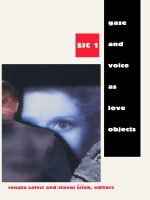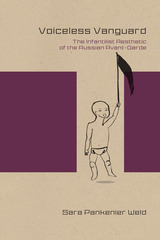3 books about Voice in literature

Gaze and Voice as Love Objects
SIC 1
Renata Salecl and Slavoj Žižek, eds.
Duke University Press, 1996
The gaze entices, inspects, fascinates. The voice hypnotizes, seduces, disarms. Are gaze and voice part of the relationship we call love . . . or hate? If so, what part? How do they function? This provocative book examines love as the mediating entity in the essential antagonism between the sexes, and gaze and voice as love's medium. The contributors proceed from the Lacanian premise that "there is no sexual relationship," that the sexes are in no way complementary and that love—figured in the gaze and the voice —embodies the promise and impossibility of any relation between them.
The first detailed Lacanian elaboration of this topic, Gaze and Voice as Love Objects examines the status of gaze, voice, and love in philosophy from Plato to Kant, in ideology from early Christianity to contemporary cynicism, in music from Hildegard of Bingen to Richard Wagner, in literature from Edith Wharton's Age of Innocence to Kazuo Ishiguro's The Remains of the Day, and in cinema from Michael Powell's Peeping Tom to Kieslowski's A Short Film on Love. Throughout, the contributors seek to show that the conflict between the sexes is the site of a larger battle over the destiny of modernity. With insights into the underlying target of racist and sexist violence, this book offers surprising revelations into the nature of an ancient enigma—love.
The first detailed Lacanian elaboration of this topic, Gaze and Voice as Love Objects examines the status of gaze, voice, and love in philosophy from Plato to Kant, in ideology from early Christianity to contemporary cynicism, in music from Hildegard of Bingen to Richard Wagner, in literature from Edith Wharton's Age of Innocence to Kazuo Ishiguro's The Remains of the Day, and in cinema from Michael Powell's Peeping Tom to Kieslowski's A Short Film on Love. Throughout, the contributors seek to show that the conflict between the sexes is the site of a larger battle over the destiny of modernity. With insights into the underlying target of racist and sexist violence, this book offers surprising revelations into the nature of an ancient enigma—love.
Contributors. Elisabeth Bronfen, Mladen Dolar, Fredric Jameson, Renata Salecl, Slavoj Žižek, Alenka Zupancic
[more]

Maternal Body and Voice in Toni Morrison, Bobbie Ann Mason, and Lee Smith
Paula Gallant Eckard
University of Missouri Press, 2002
Throughout human history, motherhood and maternal experience have been largely defined and written by patriarchal culture. Religion, art, medicine, psychoanalysis, and other bastions of male power have objectified the maternal and have disregarded female subjectivity. As a result, maternal perspectives have been ignored and the mother’s voice silenced. In recent literary texts, however, more substantial attention has been given to motherhood and to the physical, psychological, social, and cultural dynamics affecting maternal experience. In Maternal Body and Voice in Toni Morrison, Bobbie Ann Mason, and Lee Smith, Paula Gallant Eckard examines how maternal experience is depicted in selected novels by three American writers, emphasizing how they focus on the body and the voice of the mother. These novels include: The Bluest Eye, Sula, and Beloved by Morrison; In Country, Spence + Lila, and Feather Crowns by Mason; and Oral History, Fair and Tender Ladies, and Saving Grace by Smith.
By employing this focus, these writers lessen the objectification the maternal has received and restore a rich subjectivity that foregrounds the mother’s perspective. Moreover, their fiction reflects a deep concern for history and culture and for a woman’s experience of her world. They challenge the traditional representations of black and white motherhood that have appeared in southern literature and society, rendering complex portrayals of motherhood that defy cultural stereotypes.
Eckard incorporates historical perspectives on African American and southern motherhood, utilizing the works of Elizabeth Fox-Genovese, Sally McMillen, Deborah White, Jacqueline Jones, and others. She draws upon the feminist criticism of Adrienne Rich, Elaine Showalter, Naomi Schor, Tillie Olsen, Karla F. C. Holloway, Barbara Christian, and others, and the linguistic and psychoanalytic theories of Julia Kristeva, Hélène Cixous, and Luce Irigaray. The author also addresses the cross-cultural connections shared by Morrison, Mason, and Smith, showing that, despite their racial and cultural differences, striking similarities can be found in their renderings of maternity.
The three women writers employ related image patterns, metaphors, and symbols involving the maternal body. By centering maternity so strongly in their novels, Morrison, Mason, and Smith establish the primacy of the mother and obviate the neglect to which maternal perspectives have been subjected. They restore the mother’s lost voice and her diminished subjectivity. Together they depict the maternal as a powerful force that shapes human lives and communities.
[more]

Voiceless Vanguard
The Infantilist Aesthetic of the Russian Avant-Garde
Sara Pankenier Weld
Northwestern University Press, 2014
Winner, 2015 International Research Society in Children's Literature (IRSCL) Book Award
Voiceless Vanguard: The Infantilist Aesthetic of the Russian Avant-Garde offers a new approach to the Russian avant-garde. It argues that central writers, artists, and theorists of the avant-garde self-consciously used an infantile aesthetic, as inspired by children’s art, language, perspective, and logic, to accomplish the artistic renewal they were seeking in literature, theory, and art. It treats the influence of children’s drawings on the Neo-Primitivist art of Mikhail Larionov, the role of children’s language in the Cubo-Futurist poetics of Aleksei Kruchenykh, the role of the naive perspective in the Formalist theory of Viktor Shklovsky, and the place of children’s logic and lore in Daniil Kharms’s absurdist writings for children and adults. This interdisciplinary and cultural study not only illuminates a rich period in Russian culture but also offers implications for modernism in a wider Western context, where similar principles apply.
Voiceless Vanguard: The Infantilist Aesthetic of the Russian Avant-Garde offers a new approach to the Russian avant-garde. It argues that central writers, artists, and theorists of the avant-garde self-consciously used an infantile aesthetic, as inspired by children’s art, language, perspective, and logic, to accomplish the artistic renewal they were seeking in literature, theory, and art. It treats the influence of children’s drawings on the Neo-Primitivist art of Mikhail Larionov, the role of children’s language in the Cubo-Futurist poetics of Aleksei Kruchenykh, the role of the naive perspective in the Formalist theory of Viktor Shklovsky, and the place of children’s logic and lore in Daniil Kharms’s absurdist writings for children and adults. This interdisciplinary and cultural study not only illuminates a rich period in Russian culture but also offers implications for modernism in a wider Western context, where similar principles apply.
[more]
READERS
Browse our collection.
PUBLISHERS
See BiblioVault's publisher services.
STUDENT SERVICES
Files for college accessibility offices.
UChicago Accessibility Resources
home | accessibility | search | about | contact us
BiblioVault ® 2001 - 2024
The University of Chicago Press









